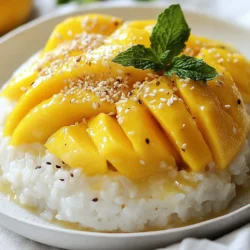
Tropical Mango Sticky Rice Delight
A delicious dessert featuring glutinous rice, coconut milk, and ripe mangoes.
Ingredients
- 1 cup glutinous rice
- 1.5 cups coconut milk
- 0.5 cup sugar
- 0.5 teaspoon salt
- 2 pieces ripe mangoes, sliced
- 1 tablespoon sesame seeds (toasted)
- pieces Fresh mint leaves (for garnish)
Instructions
- Rinse the glutinous rice under cold water until the water runs clear. Soak the rice in water for at least 4 hours or overnight.
- Drain the rice and place it in a bamboo steamer lined with cheesecloth or in a heatproof dish. Steam the rice over simmering water for about 25-30 minutes, or until it's tender and sticky.
- While the rice is steaming, prepare the coconut sauce. In a saucepan, combine coconut milk, sugar, and salt. Heat gently, stirring until the sugar completely dissolves; do not bring to a boil. Reserve about 1/3 cup for drizzling later.
- Once the rice is cooked, transfer it to a bowl and pour the remaining coconut sauce over it. Mix well, letting the rice absorb the sauce for about 10 minutes.
- To serve, place a portion of the sticky rice on a plate, fan out the mango slices next to it, and drizzle with the reserved coconut sauce.
- Top with toasted sesame seeds and garnish with fresh mint leaves.
Notes
Soaking the rice overnight enhances the texture.